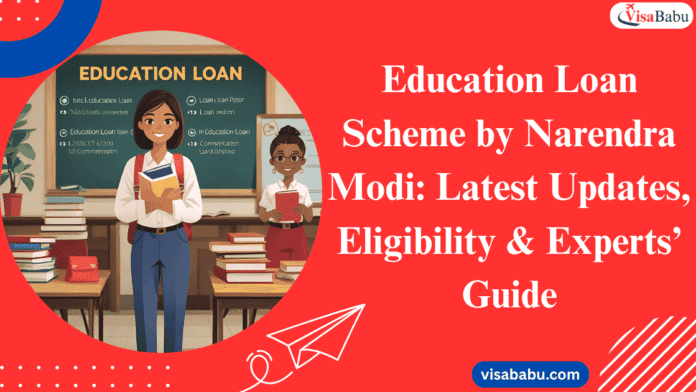Already having dreams of pursuing your education in one of the best universities in India or in a foreign land, and fearing the financial aspect of it? The new education loan scheme by Narendra Modi might be the answer you’re looking for. Built specifically to cater to the young population of India, this initiative aims to turn academic dreams into a reality through such benefits as collateral-free loans and a completely digital application experience. The government has lately introduced major changes to what is currently famously referred to as the PM Vidyalaxmi scheme. These loans are now available to over 22 lakh students studying in over 860 best-ranked institutions annually. Among the key highlights is the fact that students getting admitted to these premier institutions will get education loans of up to 10 lakh without collateral and without a guarantor. The government is giving a 75 per cent credit guarantee on loans of up to 7.5 lakh to ensure that the banks are motivated to give credit limit approvals to the students.
Students whose families have middle-income with annual earnings of up to 8 lakh are entitled to a 3% interest subsidy on loans of up to 10 lakh taken during the course of study and the consequent moratorium. The whole process is conducted via the Prime Minister-Vidyalaxmi portal, which electronically does the job, starting with application to disbursement. The scheme is an important component of the National Education Policy (NEP) 2020 and will operate in addition to the already existing schemes, such as the Central Sector Interest Subsidy (CSIS) and Credit Guarantee Fund Scheme for Education Loans (CGFSEL)59. It gives particular attention to students who follow technical or professional programs in state-owned institutions. The scheme will cover 7 lakh new students every year with a ₹3,600 crore budgetary allocation from 2024-25 to 2030-31. In addition, full interest subvention is available to students whose family income is up to ₹4.5 lakh under the PM-USP CSIS.
What is the Education Loan Scheme by Narendra Modi? A New Era for Higher Education Funding in India
The education loan scheme by Narendra Modi, now widely known as the PM Vidyalaxmi scheme, is a government-led initiative aimed at providing accessible and affordable financial support to deserving students. The ultimate aim is to make sure that none of the talented students are withheld from seeking higher education in the best institutions of India or even in foreign countries due to financial strains. The Indian government has applied this student loan scheme in an effort that is bigger than themselves, which is to provide quality education to all. It is being administered in one digital education loan portal, the PM-Vidyalaxmi portal, which gives a clear and simple application process to all the applicants.
The scheme proposes special loan products which are collateral-free as well as guarantor-free, which is a big relief to the students belonging to the middle class and the economically weaker sections of society. The government is really making a huge effort by easing the procedure and giving financial aid, such as interest subsidies, to help the young generation of the country realise their academic fantasies. This program is part of the National Education Policy 2020 vision of giving financial support to deserving students in both public and private institutions of higher learning.
PM Vidyalaxmi Scheme at a Glance in 2025
| Feature | Details |
| Scheme Name | Pradhan Mantri Vidyalaxmi (PM Vidyalaxmi) Scheme |
| Main Benefit | Collateral-free, guarantor-free loans for meritorious students |
| Eligible Students | Students admitted to Quality Higher Education Institutions (QHEIs) |
| Institutions Covered | Top 100 NIRF-ranked institutions, state HEIs ranked 101-200, all central govt. institutions |
| Interest Subsidy | 3% interest subvention on loans up to ₹10 lakh for families with income up to ₹8 lakh |
| Credit Guarantee | 75% government guarantee to banks for loans up to ₹7.5 lakh |
| Application | Through the unified PM-Vidyalaxmi digital portal |
Key Features of the PM Vidyalaxmi Education Loan Scheme in 2025
The PM Vidyalaxmi scheme is loaded with various student-friendly features which are aimed at reducing the higher education financial load. Eliminating collaterals to subsidising interest, the scheme covers some of the most frequent obstacles that a student can have when availing a study loan to Indian students.
The Advantage of a Collateral-Free Student Loan in 2025
A standout feature of this education loan scheme by Narendra Modi is the provision for collateral-free and guarantor-free loans. Students gaining admission in NIRF-ranked institutions will be able to avail education loan of up to 10 lakh without offering any collateral (such as property or assets) to the bank, and without a third-party guarantor. This comes as a huge reprieve to the students belonging to the middle classes and economically disadvantaged groups who do not necessarily have any valuable assets to mortgage as collateral, and therefore, access to higher education in India has become easier than ever before.
75% Credit Guarantee for Banks
To make banks lend more liberally under this scheme, the government provides a guaranteed credit of 75 per cent of the amount outstanding and defaulted on loans up to ₹7.5 lakh. This implies that in case a student fails to repay the loan, the government absorbs a huge percentage of the loss to the bank. This assurance lessens the risk to the financial institutions, and they are therefore more ready to give education loans to deserving students.
Interest Subsidy on Middle-income Families.
The plan offers a massive advantage to students whose families’ earnings are up to 8 lakh rupees. During the moratorium period (the course duration plus one year), they can get a subsidy of 3 per cent interest subsidy on loans of up to 10 lakh. One lakh students are given this benefit every year, and preference is expected to be given to students attending government institutions and taking up technical or professional courses. This aspect increases the affordability of the Pradhan Mantri education loan in the critical formative years.
Full Interest Subvention for Low-Income Families
It is even higher for the students whose family income is ₹4.5 lakh and below per annum. These students are provided with a complete interest subvention on education loans of up to 10 lakh during the moratorium period under the Pradhan Mantri Uchchatar Shiksha Protsahan (PM-USP) Central Sector Interest Subsidy (CSIS) scheme that is supplemented by the PM Vidyalaxmi scheme. This effectively makes the loan of professional courses in India interest-free as long as the student is studying, as the government takes the full interest burden on itself on behalf of the student.
The Ease of a Digital Education Loan Portal in 2025
The entire education loan scheme by Narendra Modi is administered through a unified digital education loan portal called PM-Vidyalaxmi. This web-based system would be transparent, easy to use and interoperable with all the banks involved. With this single portal, students are able to:
- Take an education loan.
- Make a single application to a number of banks.
- Monitor the application status in real-time.
- Subsidy benefits on access interest.
The online procedure makes the application simpler and requires less paperwork, and is less likely to irritate the students.
Eligibility Criteria for Education Loan Scheme by Narendra Modi in 2025
To be eligible for the education loan scheme by Narendra Modi, students must meet specific criteria related to their admission and the institution they plan to attend. It targets meritorious students who have already gotten admission into a quality higher education institution (QHEI).
The major eligibility criteria are:
- Nationality: The student should be an Indian national, including Non-Resident Indians (NRIs) and Overseas Citizens of India (OCIs).
- Academic Qualification: The candidate must have passed his/her 10+2 examinations.
- Admission: The learner should have gained admission to a QHEI recognised on merit. This covers the top 100 institutions of the overall NIRF, category-wise or domain-wise NIRF rankings.
- Institutional Coverage: Higher educational institutions controlled by the state governments, falling in the category of 101-200 in NIRF ranking, as well as all central government institutions, fall under the scheme.
- Courses Covered: The scheme sponsors undergraduate, post-graduate and doctoral courses in India and in foreign countries.
It should be kept in mind that the students who are expelled/suspended from their institution due to disciplinary reasons or drop out of their course without medical reasons will not get the benefit of interest subvention/credit guarantee.
Eligibility for Interest Subsidies
| Family Annual Income | Loan Amount | Interest Subsidy Details | Applicable Scheme |
| Up to ₹4.5 lakh | Up to ₹10 lakh | 100% interest subvention during moratorium | PM-USP CSIS13 |
| ₹4.5 lakh to ₹8 lakh | Up to ₹10 lakh | 3% interest subvention during moratorium | PM-Vidyalaxmi13 |
Loan Amounts, Coverage, and Repayment Terms
The education loan scheme by Narendra Modi is designed to be flexible and cover a wide range of expenses associated with higher education. It is instrumental that the applicants comprehend the size of the loan, its inclusions, and the repayment conditions.
Covered expenses and loan Amounts
The PM Vidyalaxmi scheme does not have any fixed upper limit for the loan. The quantity approved is in accordance with the actual requirement, which involves:
- Tuition fees are to be paid to the college or university.
- Hostel and mess fees.
- Examinations, library and laboratory charges.
- Books, equipment, instruments and uniforms.
- Buy a fairly priced computer or laptop.
- Any other reasonable costs connected with completing the course.
There is no limit on the amount of loan, but the credit guarantee by the government is on loans up to 750,000 rupees, and the interest subsidy is available on loans up to 10 lakh. Banks can use their general collateral requirements on loans that are larger than these values.
Understanding Interest Rates for Student Loans in India
Interest rates of student loans in India under this scheme will differ according to the banks and may be based on the rating of the educational institution. As an illustration, Punjab National Bank (PNB) divides institutions into categories (AAA, AA, A) and provides distinct rates to each one of them, where the interest rates begin as low as 7.50% per annum. Typically, the present education loan interest rates may be between 8.1 per cent to 18 per cent on a loan of 10 lakh. Students are advised to visit the PM-Vidyalaxmi portal and compare the opportunities provided by various banks in order to secure the best deal.
Repayment Conditions and Moratorium
One of the main advantages of the scheme is the lenient repayment plan. Repayment of the loan begins after a moratorium period, which is commonly the number of years the course takes, plus 6 to 12 months. This allows the students time to secure a job upon the completion of their studies before they have to start repaying. The overall repayment period is up to 15 years, excluding the moratorium period, which gives the students enough time to pay the loan without straining. The interest subsidies provided in the scheme are available within this moratorium period only, and make the load lighter in those periods when the students are not earning.
How to Apply: Step-by-Step Guide to the PM Vidyalaxmi Portal in 2025?
Applying for the education loan scheme by Narendra Modi is a completely digital process managed through the PM-Vidyalaxmi portal. It is offered on this centralised platform where one can easily apply to numerous banks using the same form. So here is a basic simulation to get you started:
- Make a registration on the Portal: Visit the official PM-Vidyalaxmi portal and register. Registration will require you to fill in your personal information such as name, cell phone number and email address.
- Common Application Form: After the registration, log in and complete the Common Education Loan Application Form (CELAF). All the information that is needed by the banks is incorporated in this single form.
- Search and Apply to Multiple Banks: You can search the available loan programmes and make applications to up to three banks of your choice with your single CELAF application.
- Upload Documents: You will be required to upload a scanned copy of the needed documents. These are better prepared in advance.
- Status of Application: Once you have applied, you may check the status of your application on the portal. The banks will change the status, and you will be informed in case of queries or the loan sanctioning.
Essential Documents Required for Application
| Document | Student | Co-applicant/Parent |
| Proof of Identity (PAN, Aadhaar) | Yes | Yes |
| Proof of Address | Yes | Yes |
| Academic Records (Mark sheets) | Yes | No |
| Proof of Admission (Offer letter) | Yes | No |
| Schedule of Expenses from Institution | Yes | No |
| Passport-size Photographs | Yes | Yes |
| Income Proof (ITR, Form 16, etc.) | No | Yes |
| Bank Account Statement (1 year) | No | Yes |
This table has been founded on the general requirements posted by the banking institutions such as the Bank of India and PNB.
Education Loan Scheme by Narendra Modi for Studying Abroad
The benefits of the education loan scheme by Narendra Modi are not limited to students studying within India. Students who want to study overseas are also supported through the scheme. Indian students who have already been admitted to the qualified undergraduate, postgraduate, or doctoral courses in foreign universities can apply to borrow funds through pm-vidyalaxmi portal.
Students studying abroad can also avail of the same features, including the possibility of collateral-free loans and interest subsidy, subject to the eligibility norms. This renders the Indian government student loan scheme an important asset to prospects seeking to attain global academic experience.
List of Banks Participating in the Education Loan Scheme by Narendra Modi in 2025
The PM Vidyalaxmi initiative is associated with a vast network of banks, thus providing students with numerous options. The portal has more than 38 public sector, private sector and cooperative banks registered. A big plus in this is the use of the PM-Vidyalaxmi portal, which enables students to view the loan products of all participating banks and apply to those that suit them best with a single application.
The following are some of the big banks involved:
- State Bank of India (SBI)
- Punjab National Bank (PNB)
- Bank of Baroda.
- Canara Bank
- HDFC Bank
- ICICI Bank
- Axis Bank
- IDBI Bank
- UCO Bank
Such a wide network makes it accessible to a large number of students nationwide.
Comparison with other schemes: A glimpse at the Modi Government Education Reforms
Modi government education reforms have taken an important initiative through the PM Vidyalaxmi scheme, which improves and expands the existing schemes. It complements the Central Sector Interest Subsidy (CSIS) and the Credit Guarantee Fund Scheme for Education Loans (CGFSEL) to make a more comprehensive support mechanism.
PM Vidyalaxmi Vs.Previous Schemes
| Feature | PM Vidyalaxmi Scheme | Earlier Schemes (e.g., CSIS) |
| Income Coverage | Broader; includes middle-income families (up to ₹8 lakh/year) for subsidies | Primarily focused on low-income groups (up to ₹4.5 lakh/year) |
| Institution Eligibility | Limited to 860 top NIRF-ranked institutions | Covered a wider range of about 20,000 NAAC/NBA-accredited institutions |
| Application Process | Centralised, fully digital via PM-Vidyalaxmi portal | Decentralised; students applied to individual banks |
| Key Benefit | Combines collateral-free loans, credit guarantees, and tiered interest subsidies | Focused mainly on full interest subsidy for a specific income bracket |
While earlier schemes laid the groundwork, the education loan scheme by Narendra Modi expands the beneficiary base to include middle-income families and streamlines the entire process through a digital-first approach.
Pros and Cons of the Education Loan Scheme by Narendra Modi in 2025
As with any other big policy, the PM Vidyalaxmi scheme also has its advantages and drawbacks. A moderate opinion is capable of assisting the students in making a wise choice.
| Pros | Cons |
| Accessible Funding: Provides collateral-free and guarantor-free loans up to ₹10 lakh. | Limited Institutional Coverage: Only for top 860 NIRF-ranked institutions. |
| Digital and Transparent: Unified PM-Vidyalaxmi portal for application and tracking. | Capped Subsidy Amount: Interest subsidy only up to ₹10 lakh loan. |
| Inclusive Support: Interest subsidies for low- and middle-income families. | Annual Quota for Subsidy: 3% interest subsidy limited to one lakh students per year. |
| Wide Bank Network: 38+ banks participate, offering competitive options. | Preference for Certain Courses: Priority to govt institutions and technical/professional. |
Tips for Maximising Your Chances of Loan Approval in 2025
The process of having your education loan approved can sail through smoothly, provided you are well prepared. The following are some of the tips on how to obtain your study loan for Indian students:
- Good Academic Profile: Banks seek meritorious students, and hence, good grades and a good academic profile are highly important.
- Bring Your Documents: It is always good to have all the required documents ready, such as your admission letter, fee structure, KYC documents, and income proof of your parents beforehand. A complete file makes the process faster.
- Apply Early: Do not wait until the last minute. The interest subsidy has a yearly limit, so it is better to apply as early as possible to have a better chance of enjoying the subsidy.
- Exploit the Functionality of the Portal: Take advantage of the PM-Vidyalaxmi portal to make comparisons on the loan offers of various banks. Compare interest rates, processing fees and other conditions to select the one that suits you the best.
- Be Accurate: Re-verify all the details you fill in the Common Education Loan Application Form (CELAF), as any inaccuracy will result in delay or rejection of your loan application.
Conclusion
The education loan scheme by Narendra Modi represents a transformative step in making higher education more accessible and affordable for the youth of India. The government has covered most of the financial obstacles that deny deserving students an opportunity to realise their dreams through interest subsidies, collateral-free loans, and simplification of the digital loan application process. This project will enable more students to access quality education in the best institutions in India and other countries without the weight of the fees straining them. And in case you are a student who aims high in your education, it is strongly advised to visit the PM-Vidyalaxmi portal and find out how this scheme can benefit you in your academic pursuit.
FAQs(Frequently Asked Questions)
Q1. What is the PM Vidyalaxmi scheme, and what are the dissimilarities with the previous education loan schemes?
Ans. A new central government scheme, the PM Vidyalaxmi scheme, is to offer collateral-free education loans digitally via a portal. Compared to older schemes, it is more inclusive, subsidising the interest of middle-income families (up to ₹8 lakh annual income), where earlier schemes such as CSIS only subsidised the interest of low-income families (up to 4.5 lakh)710. It also concentrates the application process in one portal, thereby making it more streamlined.
Q2. Who will get the benefit of the 3% interest subsidy scheme of the PM Vidyalaxmi scheme?
Ans. Students whose family earns up to 8 lakh annually will get a 3 per cent interest subsidy on a bank loan up to 10 lakh during their moratorium period. One lakh students per annum will be eligible for this benefit, priority being given to students in government institutions and taking technical or professional courses.
Q3. Am I eligible to apply loan when I am undertaking a course in another country?
Ans. Yes, the scheme’s assistance to the students seeking higher education abroad covers undergraduate, postgraduate and doctoral courses also. An application can be made online through the M-Vidyalaxmi portal, and the same benefits might be applicable, provided one fulfils the eligibility norms.
Q4. Here is how to check the status of the education loan application on the PM Vidyalaxmi portal.
Ans. Once you have applied using the PM-Vidyalaxmi portal, you will be able to log in to your account and check the status of your application in real-time. The portal displays the updates of the banks you have applied to, on whether the loan has been approved, pending, or additional information is required.
Q5. What will occur in case I default on the education loan under this scheme?
Ans. The government guarantees the bank 75 per cent credit linkage on the outstanding default amount on loans up to 7.5 lakh. This is security to the bank and a motivation to lend. But failure to repay a loan will adversely affect your credit rating, and hence it will be hard to access loans in the future. The bank is also entitled to be repaid by the student from future earnings.








